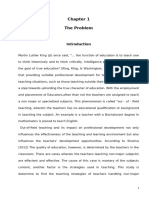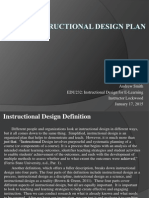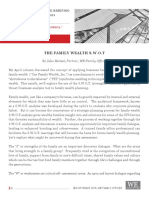A21CS Assignment 1
A21CS Assignment 1
Uploaded by
Dave SecombCopyright:
Available Formats
A21CS Assignment 1
A21CS Assignment 1
Uploaded by
Dave SecombOriginal Description:
Copyright
Available Formats
Share this document
Did you find this document useful?
Is this content inappropriate?
Copyright:
Available Formats
A21CS Assignment 1
A21CS Assignment 1
Uploaded by
Dave SecombCopyright:
Available Formats
INTRODUCTION:
The workplace of the 21st century is defined by two elements - people and technologies (Griffin & Care, 2014). It is
no longer sufficient to assume all resources and technologies are known and constant, or to believe that employees
can learn all of the academic, technical or vocational skills that are required in this context. The dynamic world that
we live in means that it isnt possible for one person to manage complex tasks alone (Griffin & Care, 2014; Care et al
2013; Hesse et al 2014). 21st century skills are defined as the skills which are emerging as increasingly important as
those skills which were as valuable in the previous century. They are not replacements for these prior skills, but
additional updates to an overall employees skill set (Griffen & Care, 2014; Care et al 2013; Hesse et al 2014). One
example of a 21st century skill is Collaborative Problem Solving (CPS). This is the practical combination of the
conceptual areas of critical thinking, communication and collaboration (www.atc21s.org).
This assignment will describe an example of CPS in a professional context. It will be completed in two parts. The first
part will describe the CPS example. The problem space will be defined, followed by a description of how the
example aligns with the features of CPS outlined by Hesse et al (2014). The second part of the assignment will use a
conceptual framework to identify two specific incidents in the example where collaborators demonstrate different
levels of skill in CPS. It will describe an example of a participant that demonstrates a high level of CPS ability, and
another who demonstrates a low level of CPS ability.
PART 1:
Problem space - The problem space for this example is the development of a coherent curriculum for an
international school in Switzerland. The setting is Grade Four, although similar examples exist in classes from
Kindergarten to Grade Six.
Participants: Classroom teachers (4), ICT specialist teacher (1), Economics specialist teachers in Middle school and
High school (2), Librarian (1), Curriculum coordinator (1), parents (3).
Rationale: This is an example of CPS primarily because one person alone does not have the expertise to define
learning targets and teaching strategies across all of the learning disciplines in the grade. The table below outlines
the indicators that make this an example of CPS and set it apart from other activities, such as group work.
Features of Collaborative Problem Solving (Hesse, Care,
Buder, Sassenberg, and Griffin, 2014)
How it is manifested in this example
Requires collaboration rather than solo effort Although this task can be performed by a single person,
the collaborative process elicits a richer, more thorough
product, resulting in better student learning. This is
because different people bring different resources to the
task, all of which are required to solve the problem of
defining what the students will be able to understand,
know and be able to do as a result of this inquiry. The
classroom teachers and curriculum coordinator identify
key elements of literacy, numeracy, science and social
studies that could be addressed within the inquiry. The
Economics teachers help to structure differentiated
learning outcomes and definitions based on their
developmental knowledge of economics. The ICT and
librarian teachers help to identify areas of digital literacy
that could be taught and assessed. Parents provide
avenues of expertise based on their professions in the
finance industry. All participants also provide a wealth of
teaching and learning strategies that could be used
throughout the inquiry.
Required more often these days as technology,
knowledge and environment are changing rapidly, and
knowledge is usually distributed.
The conceptual understanding and factual knowledge
required to effectively solve this problem is distributed
across a range of people. The dynamic nature of the
current economic environment (Robinson, 2010) in
particular indicates the collaborative imperative that
exists - a single teacher would not be able to stay up to
date with current trends across all disciplines.
PART 2:
Problems are often ill-defined and/or ambiguous. The definition of the problem itself is relatively straight-
forward - what should our students be able to
understand, know and do? It is when an attempt at
solving it happens, that it becomes more messy, as
inquiry generally is (Short, 2009). The changing nature of
the economic climate, as well as new teaching
initiatives, theories of learning and assessment practices
means that the problem becomes ambiguous.
More ways than one to solve the problem. The PYP is a transferrable international curriculum and,
although it provides scope and sequence documents
for numeracy and literacy, the expectation is for
individual schools to develop their own curriculum for
science and social studies within their unique context
(Developing a Transdisciplinary Programme of Inquiry,
IBO, 2012). This means that, although the general
structure will look similar across all PYP schools, there are
many different ways to solve this problem and teachers
need to have flexibility to face different approaches in
each school that they work in.
The solution to the problem needs to be negotiated and
agreed between collaborators.
Without clarity, teachers fall back on what they know
and how they operated in the past. This problem must
be negotiated between and agreed upon by all
members of this group. This is because once they leave
the structure of the planning meeting, each teacher will
lead their individual class into the inquiry. If this problem
is not agreed upon between all participants then not all
students will receive the same learning opportunities.
Participant CPS
ability
Behaviour description Framework element
evidence
A High Participant A (ICT specialist) adapts her working style
and level of focus to suit each teacher in their zone of
proximal development within her discipline. She
suggests learning targets for students based on what
they are expected to have achieved in this grade
and also arranges team teaching time with each class
in order to help ensure that these targets are met.
Social: Participation
(interaction).
Perspective taking
(audience awareness)
Social Regulation (self-
evaluation; transactive
memory).
Cognitive: Task regulation
(sets goals; resource
management; flexibility;
systematicity).
Learning and knowledge
building (contingencies;
hypothesis)
B Low Participant B (classroom teacher) refuses to accept
the ideas and opinions of other group members. He
believes that his approach is the only correct way to
solve this problem and will not entertain the thought of
adapting his way of working, even if it means
sacrificing the collaborative element.
He also fails to complete key elements of his role in the
process of moderating developmental descriptors of
learning.
Social: Participation
(interaction)
Social regulation
(negotiation).
Cognitive: Task regulation
(resource management)
Social: Participation (task
completion/perseverance).
REFERENCES:
Care, E., Griffin, P., Woods, K., Mountain, R. (2013). Defining and Assessing 21st Century Skills. Assessment
Research Centre, Melbourne Graduate School of Education, Melbourne University, Victoria.
Hesse, F., Care, E., Buder, J., Sassenberg, K., & Griffin, P., (in press). A Framework for Teachable Collaborative
Problem Solving Skills. In P. Griffin and E. Care (Eds.) Assessment and Teaching of 21st Century Skills: Methods and
Approach. Educational Assessment in an Information Age. Dordrecht, Springer Science and Business Media.
International Baccalaureate Organisation (2012) Developing a Transdisciplinary Programme of Inquiry. Cardiff,
Wales, UK.
Robinson, K. (2001) Out of Our Minds: Learning to be creative. Capstone Publishing, Chichester, West Sussex,
UK.
Short, K. (2009) Inquiry as a stance on curriculum. In Taking the PYP Forward. John Catt Educational Ltd.
www.atc21s.org - accessed July 12th, 2014
www.ibo.org - accessed July 12th, 2014
You might also like
- Bha Maths POIDocument2 pagesBha Maths POIDave Secomb100% (5)
- Motivating Project Based Learning Sustaining The Doing Supporting The LearningDocument31 pagesMotivating Project Based Learning Sustaining The Doing Supporting The LearningCristina100% (1)
- National Competency Based Teacher Standards NCBTSDocument4 pagesNational Competency Based Teacher Standards NCBTSLucky MariaNo ratings yet
- National Competency Based Teacher StandardsDocument3 pagesNational Competency Based Teacher StandardsEdilbert Bonifacio GayoNo ratings yet
- Lin, Schwartz, & Hatano, 2005Document11 pagesLin, Schwartz, & Hatano, 2005Emily Marshman LanderNo ratings yet
- VND - Openxmlformats Officedocument - Wordprocessingml.document&rendition 1Document32 pagesVND - Openxmlformats Officedocument - Wordprocessingml.document&rendition 1Raima CABARONo ratings yet
- Collaborative Problem SolvingDocument7 pagesCollaborative Problem Solvingabinashroutaray097No ratings yet
- Social and Emotional LearningDocument22 pagesSocial and Emotional LearningCR Education100% (1)
- RRL MathDocument7 pagesRRL MathJobelle CanlasNo ratings yet
- Finale Chapter 1Document15 pagesFinale Chapter 1Kyle LeysonNo ratings yet
- 1 Running Head: Change Agent ProjectDocument22 pages1 Running Head: Change Agent Projectapi-533829722No ratings yet
- Singer, Voica. (2013) - A Problem-Solving Conceptual Framework... Educational Studies 83Document18 pagesSinger, Voica. (2013) - A Problem-Solving Conceptual Framework... Educational Studies 83X YNo ratings yet
- Atp SliderDocument9 pagesAtp Sliderkhiwatshuma25No ratings yet
- Module 1 - Introduction To Problem-Based LearningDocument4 pagesModule 1 - Introduction To Problem-Based LearningLuz Adriana MejiaNo ratings yet
- MODULE 5 Building and Enhancing New Literacies Across The CurriculumDocument13 pagesMODULE 5 Building and Enhancing New Literacies Across The CurriculumLance Austria100% (1)
- Ietpp - Udl Frame WorkDocument9 pagesIetpp - Udl Frame Workapi-409728205No ratings yet
- Hmef5073 V2Document10 pagesHmef5073 V2Octavius GuNo ratings yet
- ESP - SummaryDocument5 pagesESP - SummaryArdelianda AugeslaNo ratings yet
- TEACHING COMPETENCIES FOR THE 21ST CENTURY RRLDocument5 pagesTEACHING COMPETENCIES FOR THE 21ST CENTURY RRLDENNIS RAMIREZNo ratings yet
- CITATION SCH13 /L 1033Document4 pagesCITATION SCH13 /L 1033Shubha JainNo ratings yet
- Action-Oriented ApproachDocument8 pagesAction-Oriented Approachsteban AlemanNo ratings yet
- Reflection 1Document12 pagesReflection 1danilo miguelNo ratings yet
- Developing An Effective Pedagogy For Creative Problem-Solving in Design and TechnologyDocument12 pagesDeveloping An Effective Pedagogy For Creative Problem-Solving in Design and TechnologyYani SantosNo ratings yet
- MajRESEARCH 19 (Chap.1-5)Document29 pagesMajRESEARCH 19 (Chap.1-5)Jammel ManzanillaNo ratings yet
- Edu5mtl Assignment 1 FinalDocument24 pagesEdu5mtl Assignment 1 Finalapi-279746002No ratings yet
- Technology For TeachingDocument26 pagesTechnology For TeachingNiño Jay CoyocaNo ratings yet
- Project Based LearningDocument10 pagesProject Based LearningRa NielNo ratings yet
- Ed 808 Advanced Educational Psychology Dr. BustosDocument6 pagesEd 808 Advanced Educational Psychology Dr. BustosDecember-Anne CabatlaoNo ratings yet
- Edld 5315 Action Research Plan ADocument13 pagesEdld 5315 Action Research Plan Aapi-677813279No ratings yet
- What Every Teacher Should Know: Reflections On "Educating The Developing Mind"Document6 pagesWhat Every Teacher Should Know: Reflections On "Educating The Developing Mind"Fitra Mencari SurgaNo ratings yet
- Bringing The Community To The School and Placing The School in The Community: New Practices and Challenges in The Teaching of Graduate StudentsDocument6 pagesBringing The Community To The School and Placing The School in The Community: New Practices and Challenges in The Teaching of Graduate Studentsfernando santosNo ratings yet
- Integrative Teaching Strategies: A SynthesisDocument13 pagesIntegrative Teaching Strategies: A SynthesisRoger Donoso BarralNo ratings yet
- 3I'SDocument7 pages3I'SShenmyer Pascual CamposNo ratings yet
- Teaching and Learning: .Edu/ics/design/teach - HTMDocument13 pagesTeaching and Learning: .Edu/ics/design/teach - HTMArvin SarasTheven SmwtNo ratings yet
- L Thompson 13747215 ISC3701 Assignment 2 PDFDocument11 pagesL Thompson 13747215 ISC3701 Assignment 2 PDFAngelo du ToitNo ratings yet
- Roles and Characteristics of Problem Solving in The Mathematics Curriculum: A ReviewDocument19 pagesRoles and Characteristics of Problem Solving in The Mathematics Curriculum: A ReviewSarahNo ratings yet
- Lecture 27Document8 pagesLecture 27junaid khanNo ratings yet
- 8603 Assignment1Document17 pages8603 Assignment1Muhammad Adnan AwanNo ratings yet
- Instructional Design PlanDocument17 pagesInstructional Design PlanAndrewSmithNo ratings yet
- JAYMAR BALIHON Research 2023Document24 pagesJAYMAR BALIHON Research 2023JAYMAR TALLEDO BALIHONNo ratings yet
- Reflections and Insights On The Models of Learning: Subject-Centered, Learner-Centered and Problem-Centered Design ModelsDocument9 pagesReflections and Insights On The Models of Learning: Subject-Centered, Learner-Centered and Problem-Centered Design ModelsMelody Dacquel-GahidNo ratings yet
- Eastern Visayas State University: Republic of The PhilippinesDocument5 pagesEastern Visayas State University: Republic of The PhilippinesLiwayway Macatimpag100% (1)
- Blooms Taxonomy & 4cDocument3 pagesBlooms Taxonomy & 4cadina paranitaNo ratings yet
- New Normal Teaching QuantitativeDocument31 pagesNew Normal Teaching QuantitativeCabigas WonhamayNo ratings yet
- Ietpp - Udl Frame WorkDocument9 pagesIetpp - Udl Frame Workapi-409728205No ratings yet
- Communication As An Educational Skill in School Units of The 21st Century: A Survey ResearchDocument9 pagesCommunication As An Educational Skill in School Units of The 21st Century: A Survey ResearchmalarNo ratings yet
- Problem-Based LearningDocument13 pagesProblem-Based LearningEstela BenegildoNo ratings yet
- Level: Curriculum Development (6406) Semester: Autumn, 2021 Course: ADE/ B.Ed (4years) Name: Saba NawazDocument21 pagesLevel: Curriculum Development (6406) Semester: Autumn, 2021 Course: ADE/ B.Ed (4years) Name: Saba NawazMuhammad Bilal100% (1)
- Chapter-1-2-3Document86 pagesChapter-1-2-3afcaro.uiNo ratings yet
- Concept Paper 3Document5 pagesConcept Paper 3RIEL JEAN GAVIOLANo ratings yet
- Social Studies Curriculum, Instruction, and Assessment PlanDocument41 pagesSocial Studies Curriculum, Instruction, and Assessment Planapi-134134588No ratings yet
- U1 SUMMARY - Pertti Kansanen & Matti Meri and GABRIEL DIAZ MAGGIOLIDocument6 pagesU1 SUMMARY - Pertti Kansanen & Matti Meri and GABRIEL DIAZ MAGGIOLIMartina Buquet IbarraNo ratings yet
- Unit 1Document10 pagesUnit 1nathan_lawler4416No ratings yet
- Nurdiana - 0203522022 - ICT - SUMMARY PPT TOPIC 1-13Document26 pagesNurdiana - 0203522022 - ICT - SUMMARY PPT TOPIC 1-13Nurdiana Kusuma AstutiNo ratings yet
- GE2 7th EXAMDocument24 pagesGE2 7th EXAMCarl Monte de RamosNo ratings yet
- HD411 - IP Working With Adults (3units) : Drugg@pacificoaks - EduDocument15 pagesHD411 - IP Working With Adults (3units) : Drugg@pacificoaks - Eduapi-291458163No ratings yet
- Chapter I FinalDocument47 pagesChapter I FinalGerland Gregorio EsmedinaNo ratings yet
- Additional Reference For Unit 2 EEd 14Document12 pagesAdditional Reference For Unit 2 EEd 14melrian.almojenoNo ratings yet
- Collaborative LearningDocument7 pagesCollaborative LearningZine EdebNo ratings yet
- Teaching EngishDocument5 pagesTeaching Engishregine alcaydeNo ratings yet
- PYP For New ParentsDocument23 pagesPYP For New ParentsDave Secomb100% (2)
- G5 HTWWDocument1 pageG5 HTWWDave SecombNo ratings yet
- The Giant of JejuDocument2 pagesThe Giant of JejuDave SecombNo ratings yet
- Difference Between Coursework and AssignmentDocument8 pagesDifference Between Coursework and Assignmentf5dthdcd100% (2)
- DLP-TEMPLATE EngDocument3 pagesDLP-TEMPLATE EngMast ErNo ratings yet
- Version 4 PR2 BOWDocument6 pagesVersion 4 PR2 BOWJean Ventura Sucuano-FraserNo ratings yet
- Reflection PseudoscienceDocument3 pagesReflection PseudoscienceSuganthi RamasamyNo ratings yet
- Chapter Iii: Sampling and Sampling DistributionDocument4 pagesChapter Iii: Sampling and Sampling DistributionGlecil Joy DalupoNo ratings yet
- 3rd QUARTER EXAMINATIONDocument5 pages3rd QUARTER EXAMINATIONAlvie Ann Lague - AyingNo ratings yet
- q1 Research 8Document46 pagesq1 Research 8wuggejejjedNo ratings yet
- Self Checklist For The Feasibility Report With ExplanationsDocument5 pagesSelf Checklist For The Feasibility Report With ExplanationsTraining Dept.No ratings yet
- John GumbelDocument18 pagesJohn GumbelJMF_CORD100% (1)
- List of Journals For CivilDocument80 pagesList of Journals For CivilPrabhakaranNo ratings yet
- INTROSTAT Ebook PDFDocument343 pagesINTROSTAT Ebook PDFKischa Doeses100% (1)
- Project Initiation To CompletionDocument4 pagesProject Initiation To Completionjesusgameboy100% (1)
- Marketing Strategies and Competitors Analysis at Ramco Cements LTDDocument4 pagesMarketing Strategies and Competitors Analysis at Ramco Cements LTDUday GowdaNo ratings yet
- Entrepreneurship AssigmentDocument7 pagesEntrepreneurship AssigmentYUNIS KHALISNo ratings yet
- Tratamiento de Los Ninos Con Paralisis Cerebral CoDocument7 pagesTratamiento de Los Ninos Con Paralisis Cerebral CoanaNo ratings yet
- Azhari CurriculumDocument8 pagesAzhari Curriculumمجهول حالNo ratings yet
- Supplier Development at SWPDocument82 pagesSupplier Development at SWPalma millaniaNo ratings yet
- Embattled Identities Jaime Holthuysen 2011Document302 pagesEmbattled Identities Jaime Holthuysen 2011Bullet to DodgeNo ratings yet
- AT - Chapter 10-Notes - Part 3Document3 pagesAT - Chapter 10-Notes - Part 3hoxhiiNo ratings yet
- Chapter 3 Quantifying Capsicum Frutescens Lip Plumping EffectDocument8 pagesChapter 3 Quantifying Capsicum Frutescens Lip Plumping EffectMhea Nicole QuilabNo ratings yet
- Barch SyllubusDocument96 pagesBarch SyllubusElsa JohnNo ratings yet
- The Family Wealth S.W.O.T: "We Stands For Wealth Enterprise."Document2 pagesThe Family Wealth S.W.O.T: "We Stands For Wealth Enterprise."Yusuff QuadrilateralNo ratings yet
- Emotional Intelligence and Self-Esteem in Regular Elementary School Adolescents, A Post-Pandemic ResearchDocument12 pagesEmotional Intelligence and Self-Esteem in Regular Elementary School Adolescents, A Post-Pandemic Researchsebastiancosmelapierre1999No ratings yet
- Food Distribution Monitoring System GUIDELINESDocument3 pagesFood Distribution Monitoring System GUIDELINESطلال مداحNo ratings yet
- FCVM 09 945726Document22 pagesFCVM 09 945726Vimal NishadNo ratings yet
- Plato On KnowledgeDocument3 pagesPlato On Knowledgedicksonogwal7No ratings yet
- A Feasibility Study of Introducing Free Economic Zones To ZimbabweDocument98 pagesA Feasibility Study of Introducing Free Economic Zones To Zimbabwesunbird.luckieNo ratings yet
- Public-Private Partnership and Circular Economy-WhDocument14 pagesPublic-Private Partnership and Circular Economy-Wh余鎮麟No ratings yet
- Gci Lime BibliographyDocument100 pagesGci Lime BibliographyKanishka SharmaNo ratings yet
- Rotary Peace Center Fact Sheet International Christian University enDocument1 pageRotary Peace Center Fact Sheet International Christian University en4comelon3sNo ratings yet





























































































